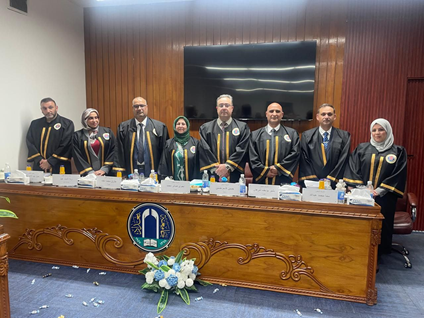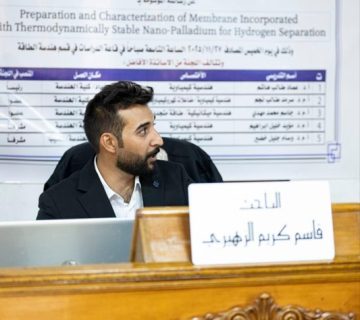The Chemical Engineering Department at the College of Engineering, University of Baghdad, held a P.hD. thesis examination titled:
“Modified Omega Zeolite for Catalytic Cracking
of Light Naphtha”
By the student “Muwafaq Mohammed Yahya” and supervised by Prof. Ass. Dr. Rana T.A. Al-Rubay and Dr. Aqeel A. T.Al-Ani. The examination committee consisted of Prof. Dr. Hussein Qasim Hussein as Chairman and the membership of Prof. Dr. Najwa Saber Majeed, Prof. Dr. Bashir Yousif Al-Zaidi, Prof. Dr. Sama M. Al-Jubouri, Ass.Prof. Dr. Tariq M. Naife. The thesis was accepted after conducting a public discussion and listening to the student’s defense. The thesis was summarized as follows:
The aim of study:
The aim of the thesis is to prepare nanoscale zeolites with porous properties through preparing an aqueous sol-gel at a temperature of up to 100°C and appropriate amount of Tetramethylammonium-hydroxide as a template to get the optimum large molecules. The development of silica to alumina ratio (Si/Al) was achieved by adding a certain amount of sulfuric acid. The effectiveness of prepared and modified zeolites as a catalyst investigated in catalytic cracking of light naphtha at different temperatures.
Abstract:
The catalytic cracking of straight-run light naphtha produced directly from the atmospheric distillation process at the Al-Dora refinery, using prepared and modified H-omega zeolite as a catalyst, yields significant products applicable in various fields.
Nano-omega zeolite with a maximum crystal size about 93 nm was synthesis by it is original hydrothermal method using parent precursors. H-omega zeolite was obtained from Na-omega by ion exchange using 1M NH4NO3. Omega zeolite preparation was successfully carried out in the presence of caustic soda, sodium aluminate, ludox 40%, and Tetramethylammonium-Hydroxide as an organic structure directing agent (OSDA) at a constant silica to alumina ratio (SiO2/Al2O3) about 10.02 at 100 °C temperature and period of time about 7 days. Different states of crystallization were studied by adding different concentrations of TMA-OH around 0.0098, 0.0077 and 0.0057 moles.
Various techniques were employed to characterize the prepared Nano-omega zeolites. These techniques included X-ray diffraction (XRD), Fourier Abstract III Transform Infrared Spectroscopy (FTIR), Scanning Electron Microscopy (SEM), Energy Dispersive X-ray Spectroscopy (EDS/EDX), Atomic Force Microscopy (AFM), BET nitrogen adsorption-desorption, and Proton Nuclear Magnetic Resonance (H-NMR).
The XRD analysis of the prepared omega zeolite shows an omega zeolite with a mazzite-type pattern, no peak shifted, and high relative crystallinity. Hydrothermal transformation of gel melt with a TMA-OH/Al2O3 mole ratio of about 0.48 resulted in regular shape crystal spherical-like omega zeolite particles as shown by SEM analysis, which is changed to single sticks after dealumination. The EDX analysis shows a silica to alumina ratio about 3.03 for fresh sodium omega zeolite, and 3.7, 4.3 for H-Omega zeolite treated with acid concentration of 0.3, 0.4 molarity of sulfuric acid respectively.
The BET surface area decreased from 213.5 to 101.988 m2 /g after calcination, while FTIR analysis shows a high density of OH group, which is responsible for zeolite acidity for all prepared and modified zeolites.
AFM analysis for fresh Na-Omega zeolite shows average particle diameter about 95 nm, average surface area14608 nm², and mean Z-maximum about 252 nm, and for calcined Na-omega zeolite about 33.7 nm, 1440 nm² and 90.64 nm respectively. For H-omega these numbers changed to 37.4 nm, 3334 nm2, 38.67 nm after 2-step ion exchange, and 52 nm, 5341 nm2, 5.359 nm after 3- steps ion exchange.
The H-NMR analysis also shows a decrease of active sites after treating the Na-omega zeolite with 0.4 molarity sulfuric acid concentration. The catalytic cracking of light naphtha using prepared and modified H-omega as a catalyst and the process carried out at a temperature range of 350-500 °C and liquid hourly space velocity (LHSV) of about 7 h-1and atmospheric pressure The resulting gases from cracking were analyzed by using GC-TCD analysis. The results showed that there were only methane and ethane gases resulting from the catalytic cracking of light naphtha. Methane gas remained at a maximum yield of 10% by weight or less at all temperatures, while ethane gas increased with increasing temperature, and the maximum yield achieved was 20% by weight at 500°C. The thermal stability of H-mega with a mesh size of 1.4-1.7 mm (granules) was confirmed by TGA analysis using nitrogen gas at 600 °C which has weight loss about 3.393%. TGA analysis was also used as an indication of coke formation using oxygen and maximum temperature about 600 °C.
The maximum weight loss including dehydration and oxidation of coke on H-Omega zeolite having mesh size between 1.4-1.7 mm, and LHSV around 22.5 h-1 reaches 4.64098 wt.%, while for finer granular particles between 0.8-1.0 mm and LHSV about 7h -1 the weight loss was about 2.0538 wt. %. The catalytic cracking kinetics of light naphtha was also studied. The activation energy value for the catalytic cracking of light naphtha was estimated experimentally using the Arrhenius equation and it was about 10.054 kJ /mol









